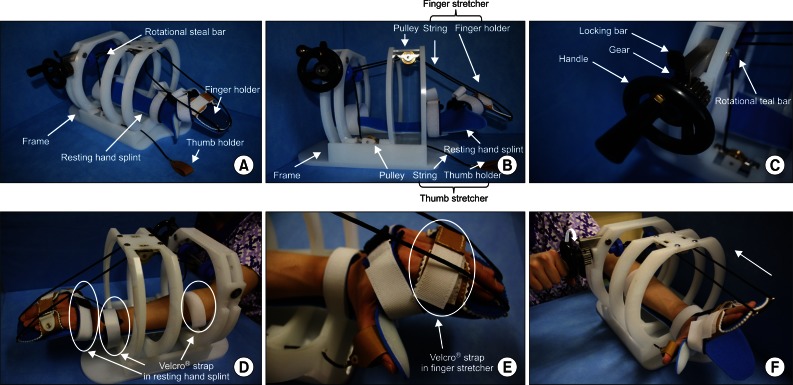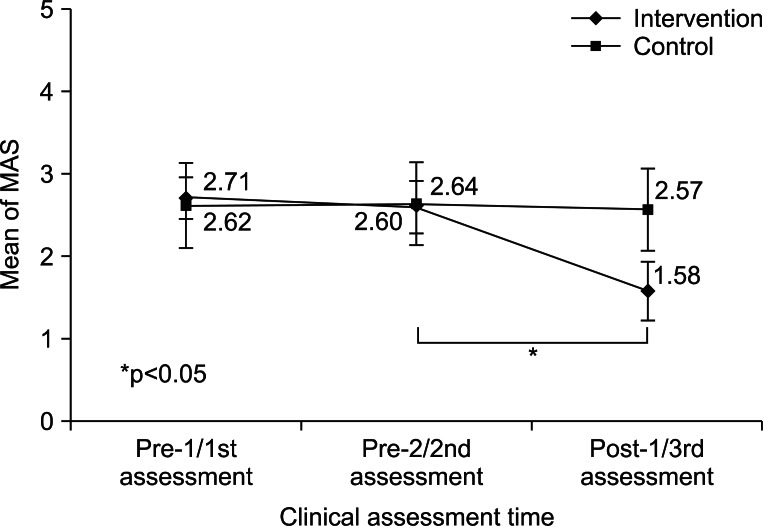Ann Rehabil Med.
2013 Apr;37(2):235-240. 10.5535/arm.2013.37.2.235.
The Effect of a Hand-Stretching Device During the Management of Spasticity in Chronic Hemiparetic Stroke Patients
- Affiliations
-
- 1Department of Physical Medicine and Rehabilitation, Yeungnam University College of Medicine, Daegu, Korea. jhm090@hanmail.net
- 2Department of Physical Therapy, Daegu Health College, Daegu, Korea.
- KMID: 2165776
- DOI: http://doi.org/10.5535/arm.2013.37.2.235
Abstract
OBJECTIVE
To describe a hand-stretching device that was developed for the management of hand spasticity in chronic hemiparetic stroke patients, and the effects of this device on hand spasticity.
METHODS
Fifteen chronic hemiparetic stroke patients with finger flexor spasticity were recruited and randomly assigned to an intervention group (8 patients) or a control group (7 patients). The stretching device consists of a resting hand splint, a finger and thumb stretcher, and a frame. In use, the stretched state was maintained for 10 minutes per exercise session, and the exercise was performed twice daily for 4 weeks. Spasticity of finger flexor muscles in the two groups was assessed 3 times, 4 weeks apart, using the Modified Ashworth Scale (MAS). Patients in the intervention group were assessed twice (pre-1 and pre-2) before and once (post-1) after starting the stretching program.
RESULTS
Mean MAS (mMAS) scores at initial evaluations were not significantly different at pre-1 in the intervention group and at 1st assessment in the control group (p>0.05). In addition, no significant differences were observed between mMAS scores at pre-1 and pre-2 in the intervention group (p>0.05). However, mMAS scores at post-1 were significantly lower than that at pre-2 in the intervention group (p<0.05). Within the control group, no significant changes in mMAS scores were observed between 1st, 2nd, and 3rd assessments (p>0.05). In addition, mMAS scores at post-1 in the intervention group were significantly decreased compared with those at the 3rd assessment in the control group (p<0.05).
CONCLUSION
The devised stretching device was found to relieve hand spasticity effectively in chronic hemiparetic stroke patients.
Keyword
Figure
Cited by 1 articles
-
Effect of Upper Extremity Robot-Assisted Exercise on Spasticity in Stroke Patients
Kyeong Woo Lee, Sang Beom Kim, Jong Hwa Lee, Sook Joung Lee, Seung Wan Yoo
Ann Rehabil Med. 2016;40(6):961-971. doi: 10.5535/arm.2016.40.6.961.
Reference
-
2. Gallichio JE. Pharmacologic management of spasticity following stroke. Phys Ther. 2004; 84:973–981. PMID: 15449979.
Article3. Sahrmann SA, Norton BJ. The relationship of voluntary movement to spasticity in the upper motor neuron syndrome. Ann Neurol. 1977; 2:460–465. PMID: 617588.4. O'Dwyer NJ, Ada L, Neilson PD. Spasticity and muscle contracture following stroke. Brain. 1996; 119(Pt 5):1737–1749. PMID: 8931594.5. Landau WM. Spasticity: the fable of a neurological demon and the emperor's new therapy. Arch Neurol. 1974; 31:217–219. PMID: 4412992.6. Jang SH, Ahn SH, Park SM, Kim SH, Lee KH, Lee ZI. Alcohol neurolysis of tibial nerve motor branches to the gastrocnemius muscle to treat ankle spasticity in patients with hemiplegic stroke. Arch Phys Med Rehabil. 2004; 85:506–508. PMID: 15031842.
Article7. Jang SH, Park SM, Kim SH, Ahn SH, Cho YW, Ahn MO. The effect of selective tibial neurotomy and rehabilitation in a quadriplegic patient with ankle spasticity following traumatic brain injury. Yonsei Med J. 2004; 45:743–747. PMID: 15344220.
Article8. Lannin NA, Novak I, Cusick A. A systematic review of upper extremity casting for children and adults with central nervous system motor disorders. Clin Rehabil. 2007; 21:963–976. PMID: 17984149.
Article9. Mori F, Koch G, Foti C, Bernardi G, Centonze D. The use of repetitive transcranial magnetic stimulation (rTMS) for the treatment of spasticity. Prog Brain Res. 2009; 175:429–439. PMID: 19660671.
Article10. Ng SS, Hui-Chan CW. Transcutaneous electrical nerve stimulation combined with task-related training improves lower limb functions in subjects with chronic stroke. Stroke. 2007; 38:2953–2959. PMID: 17901383.
Article11. Oki A, Oberg W, Siebert B, Plante D, Walker ML, Gooch JL. Selective dorsal rhizotomy in children with spastic hemiparesis. J Neurosurg Pediatr. 2010; 6:353–358. PMID: 20887108.
Article12. Turk R, Burridge JH, Davis R, Cosendai G, Sparrow O, Roberts HC, et al. Therapeutic effectiveness of electric stimulation of the upper-limb poststroke using implanted microstimulators. Arch Phys Med Rehabil. 2008; 89:1913–1922. PMID: 18760770.
Article13. Selles RW, Li X, Lin F, Chung SG, Roth EJ, Zhang LQ. Feedback-controlled and programmed stretching of the ankle plantarflexors and dorsiflexors in stroke: effects of a 4-week intervention program. Arch Phys Med Rehabil. 2005; 86:2330–2336. PMID: 16344031.
Article14. Wu CL, Huang MH, Lee CL, Liu CW, Lin LJ, Chen CH. Effect on spasticity after performance of dynamic-repeated-passive ankle joint motion exercise in chronic stroke patients. Kaohsiung J Med Sci. 2006; 22:610–617. PMID: 17116622.
Article15. Pin T, Dyke P, Chan M. The effectiveness of passive stretching in children with cerebral palsy. Dev Med Child Neurol. 2006; 48:855–862. PMID: 16978468.
Article16. Tsai KH, Yeh CY, Chang HY, Chen JJ. Effects of a single session of prolonged muscle stretch on spastic muscle of stroke patients. Proc Natl Sci Counc Repub China B. 2001; 25:76–81. PMID: 11370763.17. Zhang LQ, Chung SG, Bai Z, Xu D, van Rey EM, Rogers MW, et al. Intelligent stretching of ankle joints with contracture/spasticity. IEEE Trans Neural Syst Rehabil Eng. 2002; 10:149–157. PMID: 12503779.18. Jung YJ, Hong JH, Kwon HG, Song JC, Kim C, Park S, et al. The effect of a stretching device on hand spasticity in chronic hemiparetic stroke patients. NeuroRehabilitation. 2011; 29:53–59. PMID: 21876296.
Article19. Bohannon RW, Smith MB. Interrater reliability of a Modified Ashworth Scale of muscle spasticity. Phys Ther. 1987; 67:206–207. PMID: 3809245.
Article20. Kaya T, Karatepe AG, Gunaydin R, Koc A, Altundal Ercan U. Inter-rater reliability of the Modified Ashworth Scale and modified Modified Ashworth Scale in assessing poststroke elbow flexor spasticity. Int J Rehabil Res. 2011; 34:59–64. PMID: 20671560.
Article21. Mehrholz J, Major Y, Meissner D, Sandi-Gahun S, Koch R, Pohl M. The influence of contractures and variation in measurement stretching velocity on the reliability of the Modified Ashworth Scale in patients with severe brain injury. Clin Rehabil. 2005; 19:63–72. PMID: 15704510.
Article22. Gregson JM, Leathley M, Moore AP, Sharma AK, Smith TL, Watkins CL. Reliability of the tone assessment scale and the Modified Ashworth Scale as clinical tools for assessing poststroke spasticity. Arch Phys Med Rehabil. 1999; 80:1013–1016. PMID: 10489001.
Article23. Bressel E, McNair PJ. The effect of prolonged static and cyclic stretching on ankle joint stiffness, torque relaxation, and gait in people with stroke. Phys Ther. 2002; 82:880–887. PMID: 12201802.
Article24. Nuyens GE, De Weerdt WJ, Spaepen AJ Jr, Kiekens C, Feys HM. Reduction of spastic hypertonia during repeated passive knee movements in stroke patients. Arch Phys Med Rehabil. 2002; 83:930–935. PMID: 12098152.
Article25. Harvey LA, Batty J, Crosbie J, Poulter S, Herbert RD. A randomized trial assessing the effects of 4 weeks of daily stretching on ankle mobility in patients with spinal cord injuries. Arch Phys Med Rehabil. 2000; 81:1340–1347. PMID: 11030499.
Article26. Monaghan K, Horgan F, Blake C, Cornall C, Hickey PPM, Lyons BE, et al. Physical treatment interventions for managing spasticity after stroke. Cochrane Database Syst Rev. 2011; 7:1–25.
Article
- Full Text Links
- Actions
-
Cited
- CITED
-
- Close
- Share
- Similar articles
-
- Correction: The Effect of a Hand-Stretching Device During the Management of Spasticity in Chronic Hemiparetic Stroke Patients
- Immediate Effect of Sustained Stretching Exercises with Far Infrared on the Ankle Range of Motion and Muscle Tone in Patients with Stroke
- The Effect of Passive Stretching on the Spasticity of Ankle Plantar Flexor Muscles
- Effects of Resting Hand Splint in Early Stroke Patients
- Effect of Motor Imagery on the F-Wave Parameters in Hemiparetic Stroke Survivors




